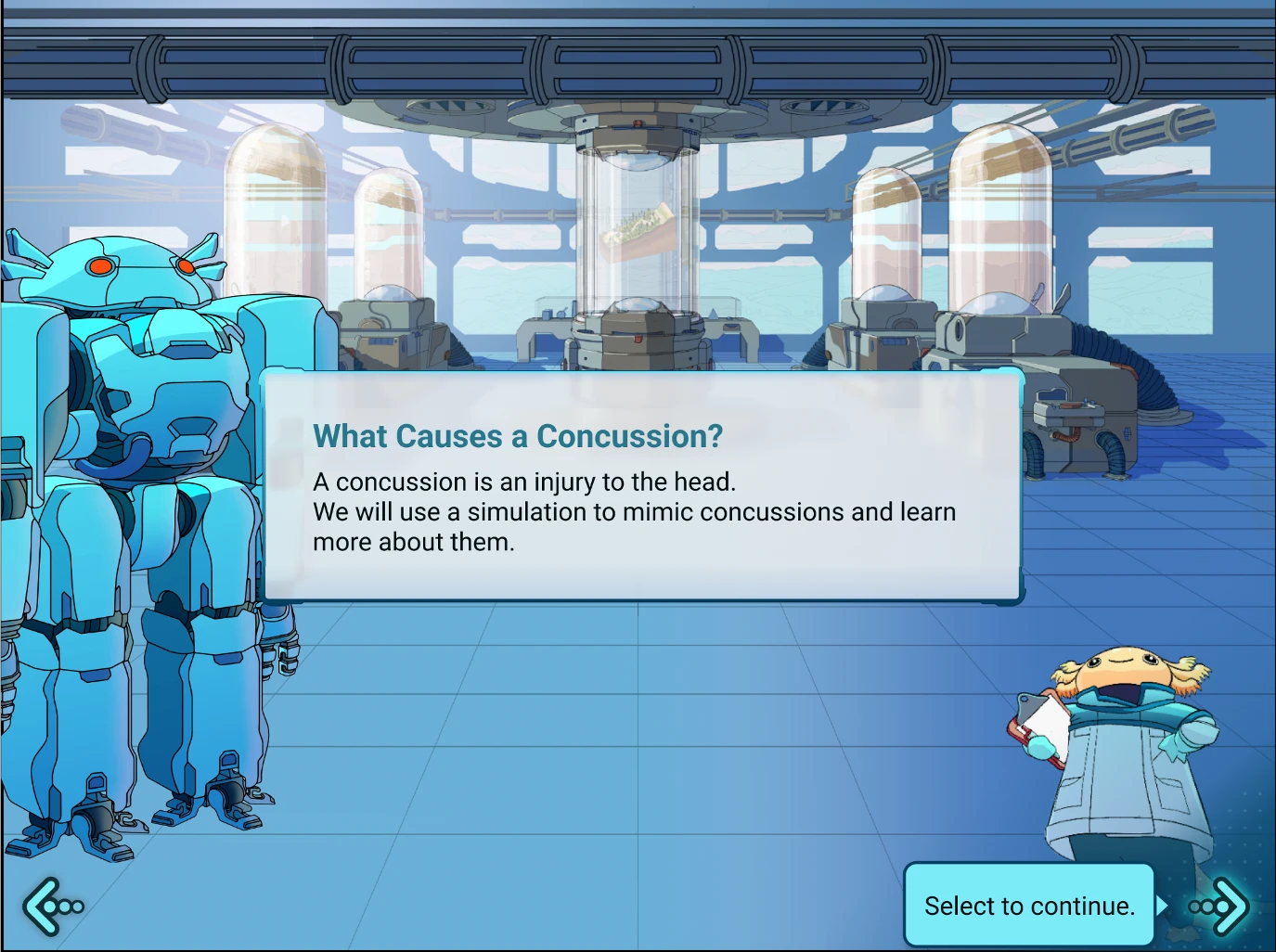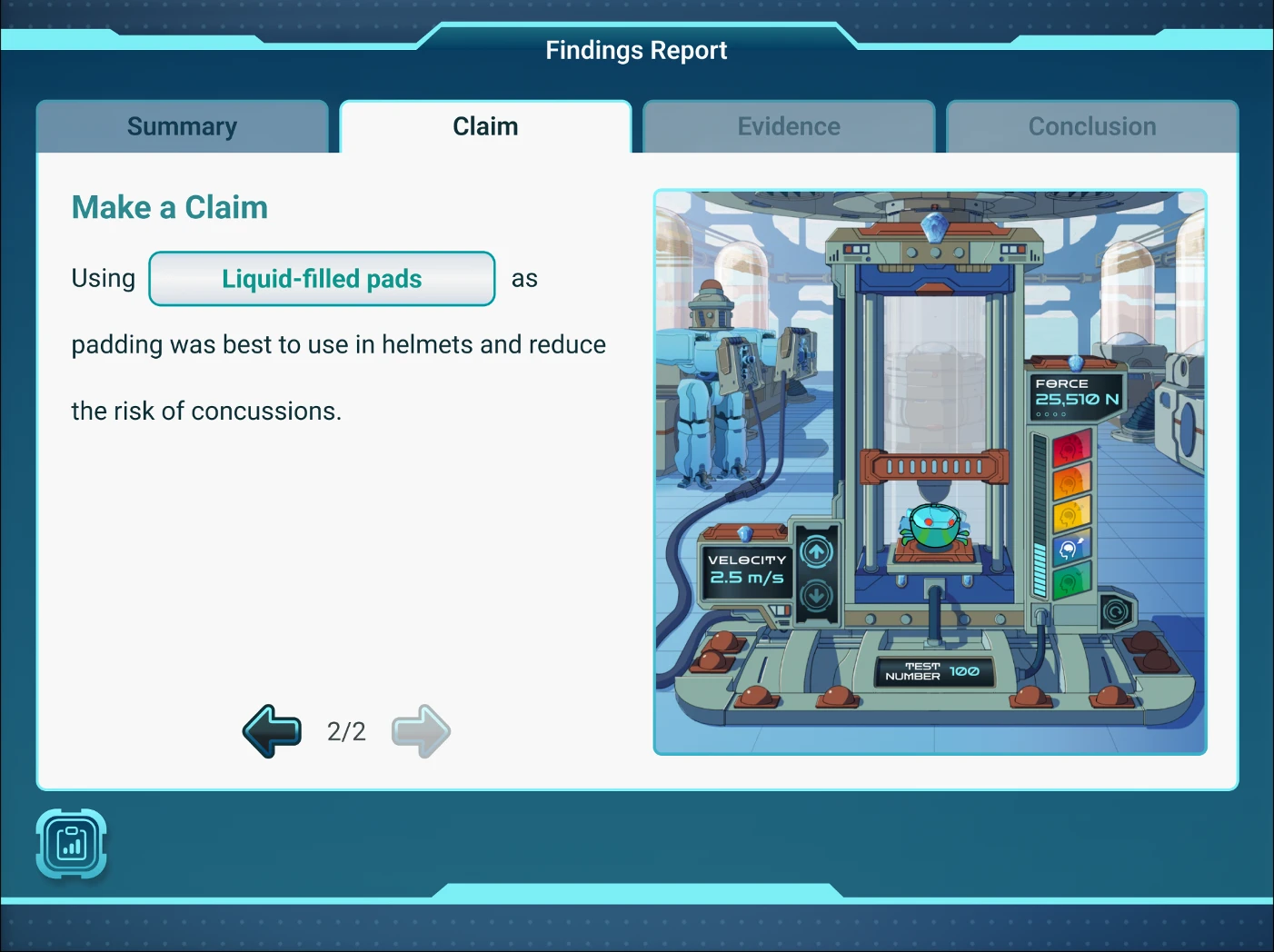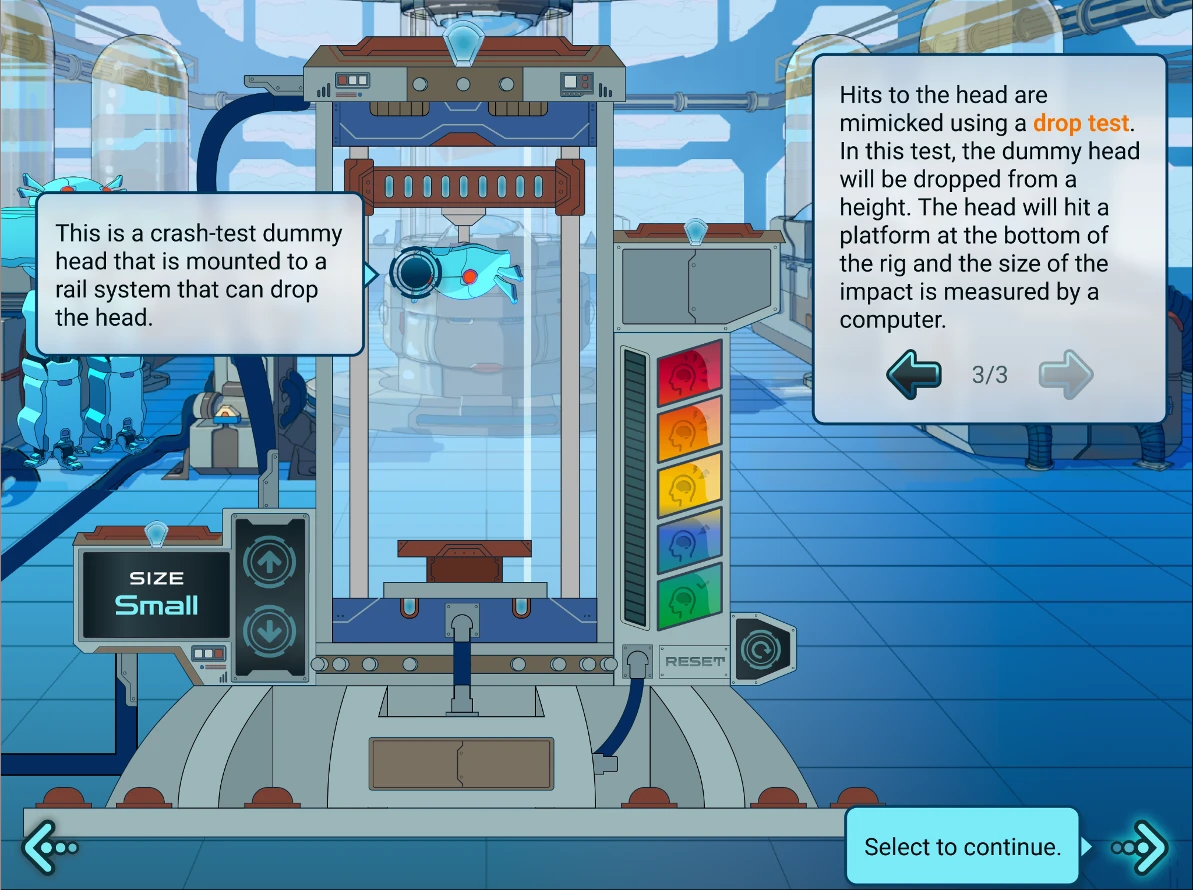Explore the Physics Behind Concussions in our Latest STEM Case

If you follow sports, especially football, you’ve heard the announcers talk about concussions. Bike and motor vehicle accidents, falls, and other blows to the head are also common causes of concussions. While it’s easy to understand that concussions are serious, the reasons why are a little more complicated.
ExploreLearning Learning Designer Lauren Schetne, Ph.D., tapped the expertise of four subject matter experts for our newest STEM Case. Tom Bowman, Ph. D., Nicholas Cecchi, Ph. D., William Ernst, Psy.D., and Meredith E. Kneavel, Ph. D., were instrumental in developing Tackling Concussions: Testing Helmet Design Using Laws of Motion. Let’s dive into the physics of concussions.
What are the physics behind concussions?
According to Dr. Cecchi, Chief Science and Product Officer at SoftShox, “Concussions commonly occur when a biomechanical force is transmitted to the head, causing the head to accelerate and the brain to experience deformation as it moves around within the skull. Such forces commonly occur in a variety of settings, including contact sports, bike riding, automotive accidents, and falls in the home and workplace.”
What kind of force creates concussions?
How do concussions relate to Newton’s laws? Newton's first law explains that an object will continue moving in a straight line unless acted upon by an outside force. Newton's second law refers to the force applied to an object being equal to its mass multiplied by its acceleration. Concussions are caused by a combination of Newton's first and second laws.
Thinking of sports, Dr. Bowman, Professor of Athletic Training at the University of Lynchburg, said, “Based on the current Consensus Statement on Concussion in Sport, ‘sport-related concussion is a traumatic brain injury caused by a direct blow to the head, neck, or body resulting in an impulsive force being transmitted to the brain that occurs in sports and exercise-related activities.’"
Dr. Kneavel, Interim Dean for the School of Nursing and Health Sciences at La Salle University, noted, “A concussion is the same but can occur from any blow to the head, neck, or body and can occur as the result of a car accident, fall, or other experience.”
The relationship between Newton’s Law and concussions
When you push or pull on something, this is called force. Concussions happen when external forces cause the brain to accelerate and decelerate.

Force is measured in units called Newtons (N). In this STEM case, students will be able to explore how force to the head and concussions are related. Ultimately, they will use their knowledge of Newton's Second Law to determine which padding material is best at reducing force delivered to the head during an impact.
Developing a concussions STEM Case
It takes a village to develop any STEM Case, and this one was no different. The Gizmos Team includes content writers, artists, and developers as well as professionals in STEM fields who make STEM Cases come to life. The STEM Pros involved in the development played crucial roles in bringing accuracy and authenticity to the project.
For example, Dr. Bowman assisted in explaining how protective sports helmets are tested and the basic pathophysiology of concussions. Dr. Cecchi said, “As a contributing member of the development team for this STEM Case, I provided insight into how shock-absorbing technologies and protective helmets are designed and tested.” He continues his work to protect athletes with the launch of the Guardian Chinstrap powered by SoftShox™, the first-ever chinstrap specifically engineered for impact absorption.
Supporting understanding of concussions and Newton’s Laws in our latest STEM Case
Tackling Concussions: Testing Helmet Design Using Laws of Motion is the latest STEM Case for grades 6-8. Designed to align with the latest educational standards and support science and engineering practices, the STEM Case revolves around concussion force and safety in youth sports. Concussions in youth sports are higher than expected, making parents wonder if their kids should play impact sports like football, hockey, or lacrosse. If players are wearing helmets during these sports, are the helmets actually doing their job?
In this STEM Case, students act as materials scientists to understand the physics behind concussions and their impacts. Using Newton’s First and Second Laws of Motion, they will test padding materials to determine which is best in reducing force during an impact and lowering the risk of concussion.

How Helmets and Safety Precautions Reduce Injuries
Protective equipment can play an essential role in reducing the risk of injury. In the STEM Case, students apply scientific ideas and principles to design, construct, and test helmet design. While helmets can reduce the forces transmitted to the head during an impact, leading to reduced head motion caused by the impact, they are not intended to prevent concussions. “Rather, they are designed to prevent more life-threatening conditions such as subdural hematomas or skull fractures,” said Dr. Bowman.
“Recent advances in shock absorber technology are pushing the limits on how much force can be reduced by a helmet. However, it is critical to recognize that no protective equipment can prevent concussion entirely, and everyone likely has a unique, individual tolerance to head impact loading,” said Dr. Cecchi.
Dr. Kneavel said, “Safe play, safe practice, reporting when a potential concussion happens, and feeling safe to report concussions to your coach or other adult are all really important parts of a larger picture that makes sports safer. Learning how to play your sport in the safest way possible is also really important. For instance, learning how to tackle in football without going head first or how to use discrete ball handling in lacrosse or safe stick use in field hockey are just as important in the safety of the game.”
Why Concussion Awareness is Essential for Kids and Parents
“Concussions are a health risk but are poorly understood by most people. Improving knowledge surrounding concussions may impact behavior,” said Dr. Bowman, making concussion education critical for injury prevention.

Dr. Cecchi said, “If children and parents both understand the signs and symptoms of concussions, and how serious these injuries can be, all are more likely to take preventative measures to avoid injury and to properly treat injury if it occurs. Furthermore, not all helmets are created equal, so understanding the efficacy of each helmet for its intended use will help to guide purchasing decisions and frequency of helmet use that could influence injury risk.”
According to Dr. Kneavel, kids need to understand the symptoms that are less well-known and less talked about. “Most kids and adults know about headaches and feeling groggy. But many kids don’t know that concussions can lead to mood changes. This can mean increased anxiety and nervousness or being more emotional,” she said. “I also think it is important for kids to know that if they see that their friend is suffering from any symptoms, it is better to say something to keep them safe now and in the future than to risk the possibility of complications later.”
Ready to discover the physics behind concussions through the real-world setting of youth sports? Investigate the STEM Case!

Interested in experiencing the impact on student achievement through virtual labs with your class? Take a free trial today!
Start My Trial
We value educators' insights on what really works in the classroom. Are you interested in being a Tech Tester for this or other STEM Cases to provide student user testing feedback? Join the Collab Crew.
About the STEM Pros

Dr. Tom Bowman
Dr. Tom Bowman is originally from central Pennsylvania and received his B.S. in Athletic Training from California University of Pennsylvania. Afterward, he earned an M.Ed. in kinesiology and a Ph.D. in higher education from the University of Virginia. Dr. Bowman currently serves as a professor in the department of athletic training at the University of Lynchburg. He has taught a wide variety of classes, including upper extremity examination, kinesiology, research design, and thesis. His research interests include head/neck injury in sport, protective equipment performance, and socialization in athletic training. He was named a Fellow of the National Athletic Trainers’ Association in 2022 for national and international excellence in athletic training research and scholarship. Much of his scholarship has included mentoring student research projects at the undergraduate or graduate level, leading to several student research awards.

Dr. Nicholas Cecchi
Dr. Nicholas Cecchi is the Chief Science and Product Officer at SoftShox (softshox.com), a Virginia-based startup focused on developing safer helmet technology. Dr. Cecchi has deep experience in researching brain injury biomechanics and designing new protective helmet technologies. Dr. Cecchi earned a B.S. in Mechanical Engineering from UC Irvine and a Ph.D. in Bioengineering from Stanford University, where he conducted concussion and headgear studies in football, lacrosse, water polo, soccer, and more. Dr. Cecchi’s work to improve safety from traumatic brain injury has led to patented inventions, commercial products, and changes in sports policy at the national level.

Dr. William Ernst
William Ernst, Psy.D. is Associate Professor and Program Director of the Doctoral Program in Clinical Psychology at William Paterson University, where he also directs the Applied Neuropsychology and Concussion Education/Intervention Lab. Previously, Dr. Ernst was Associate Professor and the Founding Director of the Center for Concussion Education and Research at Chestnut Hill College in Philadelphia, where he developed a novel peer concussion education program with his colleague, Dr. Meredith E. Kneavel, with funding from the NCAA and Department of Defense. He has published and presented both nationally and internationally. Dr. Ernst’s research focuses on concussion prevention, increasing concussion disclosure of sports-related concussion to healthcare personnel, and knowledge of traumatic brain injury among various professional groups. Dr. Ernst completed a postdoctoral fellowship in clinical neuropsychology within the neurology department at the University of Medicine and Dentistry of New Jersey/Cooper Hospital. In addition, he maintains an independent clinical practice where he evaluates children and adults with concussion and traumatic brain injury.

Dr. Meredith Kneavel
Dr. Meredith E. Kneavel is a neuroscientist who serves as a professor of public health and interim dean in the School of Nursing and Health Sciences at La Salle University in Philadelphia. She holds a Ph.D. from the Graduate School and University Center of the City University of New York in psychology with a concentration in biopsychology. She earned her B.S. in Psychology from Loyola University in Maryland. Her expertise is in neuroscience, research design, and analysis. Her current research spans three main areas: athlete safety, stress, and pedagogy. Dr. Kneavel’s athlete safety research has focused on understanding the culture surrounding concussion reporting to include broader athlete safety. She and her colleague, Dr. William Ernst, developed and assessed a novel peer concussion education program supported through grants from the NCAA and Department of Defense.